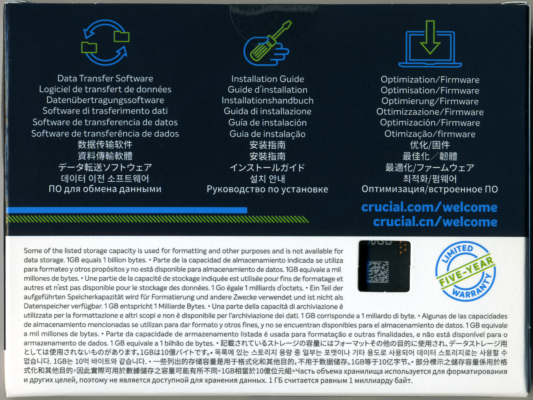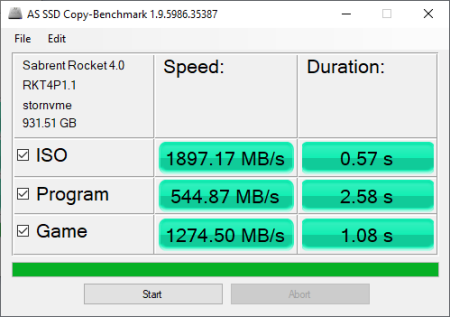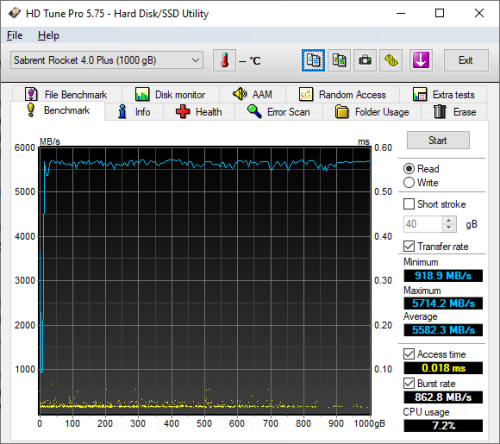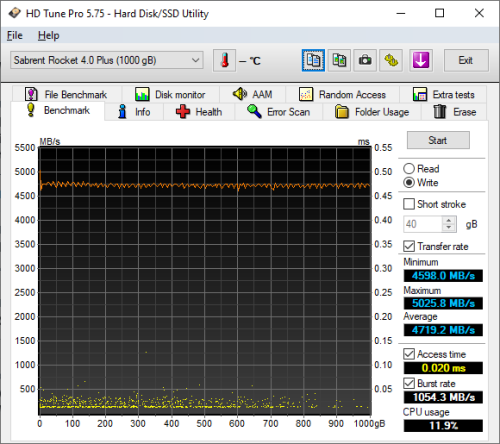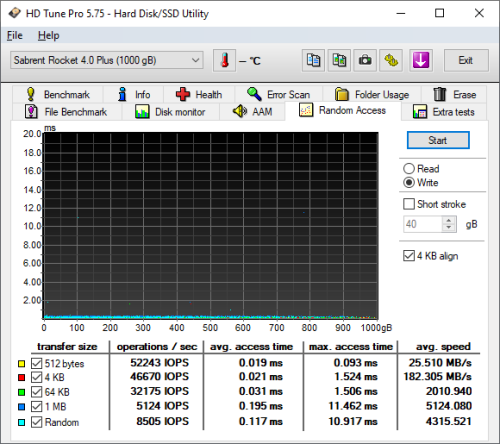

Model: Crucial P5 Plus 1TB PCIe 4.0 NVMe M.2 Solid State Drive
Manufacturer: Crucial
Provided By: Crucial
Crucial is a global brand of Micron Technology, Inc., one of the largest memory and flash storage manufacturers in the world. The company's product lineup includes award-winning solid state drives (SSDs) and computer memory upgrades (DRAM) for more than 50,000 systems. These products have been qualified and approved by major original equipment manufacturers and every single module has been rigorously tested at the component and module level. Each SSD also undergoes over a thousand hours of prerelease validation testing and hundreds of qualification tests to ensure optimal reliability and performance.
The latest addition to Crucial's line of NVMe solid state drives is the P5 Plus. Designed specifically for intensive workloads, high-quality creative content and hardcore gaming, this M.2 form factor drive is powered by Micron's own DM02A1 controller and is available with up to 2TB of their industry-leading 176-layer 3D TLC NAND flash. The P5 Plus also includes advanced features like full dynamic write acceleration, error correction, full hardware-based encryption and adaptive thermal protection to keep your data safe while enhancing system reliability. To top it all off, the drive is equipped with an ultra-fast PCIe Gen4 x4 NVMe 1.4 interface and is capable of 6,600 MB/s read and 5,000 MB/s write speeds.
The P5 Plus is available in 500GB, 1TB and 2TB capacities. For this review, Crucial sent us the 1TB version of the drive which is capable of delivering up to 6,600 MB/s sequential read and 5,000 MB/s sequential write speeds as well as up to 630,000 random read and 700,000 random write IOPS.
| Crucial P5 Plus 1TB PCIe 4.0 NVMe M.2 Solid State Drive | |||||||||||||||||||||||||||
General Specifications
Performance
Reliability
Environmental
Other Features
|
Needless to say, this is only a taste of what the P5 Plus has to offer. To give you an idea of what to expect, we'll take a closer look at Crucial's new PCIe 4.0 SSD and then see how well it performs. Does the P5 Plus have what it takes? Can it deliver the performance and features that we've come to expect from Crucial? Keep reading as we find out.
The P5 Plus comes in a small, blue and white box. While there aren't a lot of technical details, the packaging advertises some of the drive's key features including its 1TB capacity, support for PCIe 4.0 NVMe technology, and 5 year warranty. The back of the box also has a small window that lets you see the drive and view the QR code on it. Inside, you'll find the P5 Plus as well as a mounting screw and a small guide with information on where you can get additional help and download the migration and cloning software.

Physical Features:
The P5 Plus uses the 2280 form factor for M.2 (NGFF) SSDs. It measures 22 x 80 x 2.25 mm and tips the scales at less than 8g. The drive also has an "M key" edge connector which provides PCIe SSDs with up to 4x lanes of bandwidth.
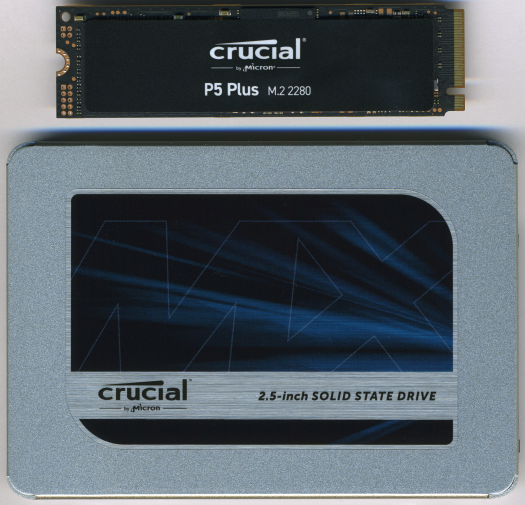
The P5 Plus is one of the first drives to use Micron's new DM02A1 controller. Not much is known about this controller aside from that it was designed in house, has eight channels and supports hardware-based encryption.


For the 1TB version of the P5 Plus, Crucial opted to use Micron's 176-layer (B47R) 3D TLC NAND flash. If you'd remove the sticker, you'd see that there are two 512GB NAND flash packages on the top of the PCB. The drive also has a single 1GB Micron LPDDR4 DRAM chip that is used for caching.
The test system used in this review is equipped with an AMD Ryzen 5 3700x CPU, MSI B550 GAMING PLUS motherboard, 16GB (8GB x 2) of Crucial Ballistix 3200 MHz DDR4 memory, Crucial P5 1TB SSD and a GIGABYTE GeForce GTX 1060 WINDFORCE OC 6G graphics card. For the operating system, I used the latest version of Windows 10 Pro.
To test the performance of Crucial's P5 Plus SSD, I ran a series of benchmarks using CrystalDiskMark, HD Tach RW, ATTO Disk Benchmark, AS SSD, HD Tune Pro, Anvil's Storage Utilities, Iometer and PCMark. For comparison, I've also included test results from the Plextor M10PY, ADATA XPG GAMMIX S70, Sabrent Rocket 4 Plus, WD_BLACK SN850, Silicon Power US70, ADATA XPG GAMMIX S50 Lite, Samsung 980, Silicon-Power UD70, Crucial P2, SK hynix Gold P31, Crucial P5, ADATA SWORDFISH, ADATA FALCON, Lexar NM610, Silicon Power P34A60, Patriot P300, Plextor M9PG Plus, Plextor M9PY Plus, ADATA XPG SX6000 Pro, Western Digital WD_BLACK SN750, Lexar NQ100, Samsung 970 EVO Plus, ADATA XPG SX8200 Pro, Crucial P1, ADATA XPG SX8200, Western Digital WD_BLACK NVMe, Samsung 970 EVO, Samsung 970 PRO, Plextor M9Pe, Plextor M8Se, Patriot Hellfire, ADATA XPG SX8000, Samsung 960 PRO, Toshiba OCZ RD400, Samsung 950 PRO, Samsung 870 EVO, Samsung 870 QVO, Silicon Power PC60 and SK hynix Gold S31.

As I mentioned earlier, the P5 Plus uses Micron's DM02A1 controller chip. Looking at the screenshot above, you can see that it performs equally well with both incompressible (0%) and compressible (100%) data.
CrystalDiskMark 8.0.4:
First, I ran a few quick tests using CrystalDiskMark. This benchmark measures the performance of a storage device by testing its sequential and random read and write speeds. For this test, we're using the peak and real world profiles.
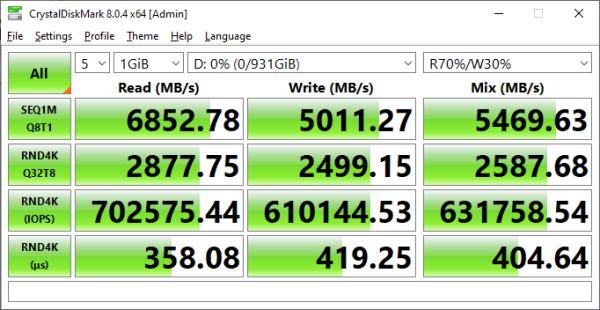
According to Crucial, the 1TB P5 Plus is capable of reading at 6,600 MB/s and writing at 5,000 MB/s. As you can see, the drive had no problems reaching these speeds in CrystalDiskMark's sequential read and write tests.

As you'd expect, the P5 Plus wasn't as fast when tested with the "real world" profile which uses a single thread and a much lower queue depth. Nevertheless, it was still able to read at 4,346 MB/s and write at more than 4,800 MB/s.
HD Tach RW 3.0.4.0:
Next, I used HD Tach to test the P5 Plus' read, write and burst speeds as well as its random access time and CPU usage.

Looking at the screenshot above, you can see that the P5 Plus had average read and write speeds of 2,185.7 MB/s and 1,354.0 MB/s respectively, as well as a burst speed of 2,525.5 MB/s. The screenshot also shows that, like most other TLC-based SSDs, the P5 Plus uses some sort of SLC caching. The drive starts writing at about 2,000 MB/s and then drops to about 1,300 MB/s when the write operation exceeds the size of the cache.
ATTO Disk Benchmark 4.01:
I also used ATTO Disk Benchmark to test the P5 Plus' sequential read and write speeds. The tests are run using blocks ranging in size from 512B to 64 MB and the total length set to 256MB.
When tested with ATTO, the P5 Plus' read speeds topped out at about 6.40 GB/s and its write speeds at 4.69 GB/s.
AS SSD:
AS SSD is a relatively new benchmark designed specifically for solid state drives. The application contains five synthetic tests used to determine the sequential and random read and write performance of a drive.
AS SSD also includes a copy benchmark. This test copies an ISO (two large files), program (many small files) and game (small and large files), returning the speed and duration of each.
HD Tune Pro 5.75:
Next, I ran a series of tests using HD Tune Pro. This hard disk utility measures a drive's performance by testing its sequential read and write speeds as well as its access time, burst rate and CPU usage. For this review, I'm also going to use it to benchmark the P5 Plus' random read and write speeds, random access times and the number of operations per second.
The P5 Plus performed relatively well when benchmarked with HD Tune. The drive had average read and write speeds of 3,928.1 MB/s and 1,588.0 MB/s, respectively.
When reading 4KB blocks, the P5 Plus reached 39,866 IOPS and had an average speed of 155.727 MB/s. The drive was even faster when writing, reaching 43,468 IOPS with an average speed of 169.800 MB/s.
Anvil's Storage Utilities:
Anvil's Storage Utilities is another benchmark designed with SSDs in mind. The standard storage benchmark measures a drive's performance by testing its transfer speeds, access times and IOPS.
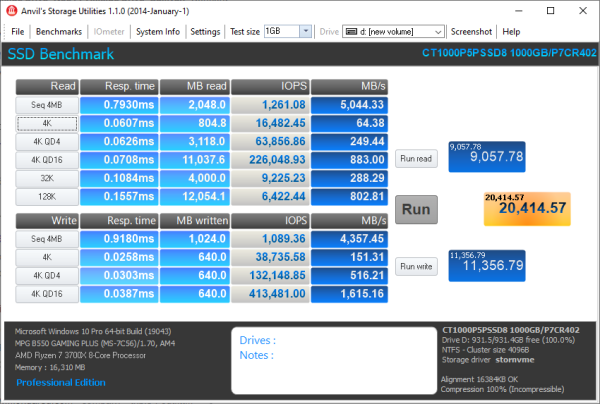
Iometer:
Lastly, I ran a series of tests using Iometer. This tool can be configured to benchmark a number of things. In this case, I used it to measure the P5 Plus' read and write speeds and the number of operations per second. The tests were run using random bytes and a queue depth of 3.

The P5 Plus' performance was very similar to what we saw in our other tests. The drive was able to read at 6177.5 MB/s and write at 4778.24 MB/s.

The P5 Plus' random read and write performance was hit and miss when tested with Iometer. While the drive was able to read at a respectable 399.20 MB/s, its write speed averaged out at only 566.53 MB/s.

According to Crucial, the 1TB P5 Plus is capable of 630,000 IOPS when reading and 700,000 IOPS when writing 4K blocks. With two threads and a queue depth of three, the drive reached 102,195 random read IOPS and 145,034 random write IOPS.

As with most drives, the P5 Plus performed better with more threads and at higher queue depths. With sixteen threads and the queue depth set to 32, it reached 697,421 random read IOPS and 657,285 random write IOPS.
PCMark 8 - Storage Test:
PCMark 8 is a complete benchmark for Windows. It includes five benchmark tests, each designed around a specific scenario. The storage benchmark measures drive performance using real-world traces recorded from Adobe Creative Suite, Microsoft Office and a selection of popular games.

PCMark 8 also includes a consistency test which measures the performance consistency and degradation tendency of a storage system. The test reports the performance level at the start, the degraded steady-state and the recovered state as well as the number of iterations required to reach the degraded state and the recovered state. For this test, we are focusing on the Adobe Photoshop (Heavy) trace and will look at both the bandwidth and latency of the drive

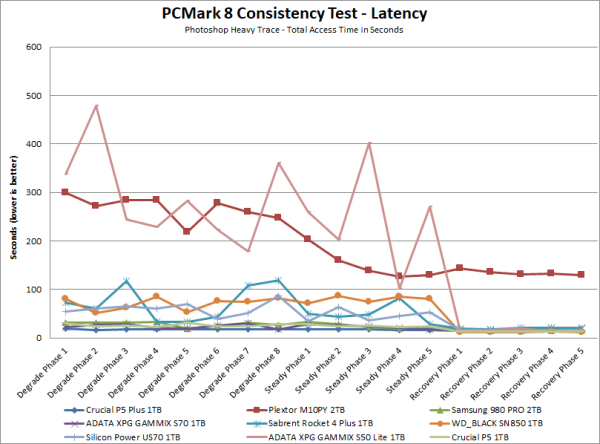
The P5 Plus' performance was hit and miss in this test. While the drive was relatively quick during the degradation and steady phases, its performance was slow to recover. The P5 Plus lagged behind the WD_BLACK SN850 and the Crucial P5 during the recovery phases, topping out at only 1050 MB/s.
PCMark 10 - Full System Drive Benchmark:
PCMark 10's Full System Drive Benchmark uses a wide-ranging set of real-world traces from popular applications and common tasks to fully test the performance of the fastest modern drives. This benchmark produces an overall score as a measure of drive performance. Comparing devices is as simple as comparing scores. The tests also measure and report the bandwidth and average access time performance for the drive.
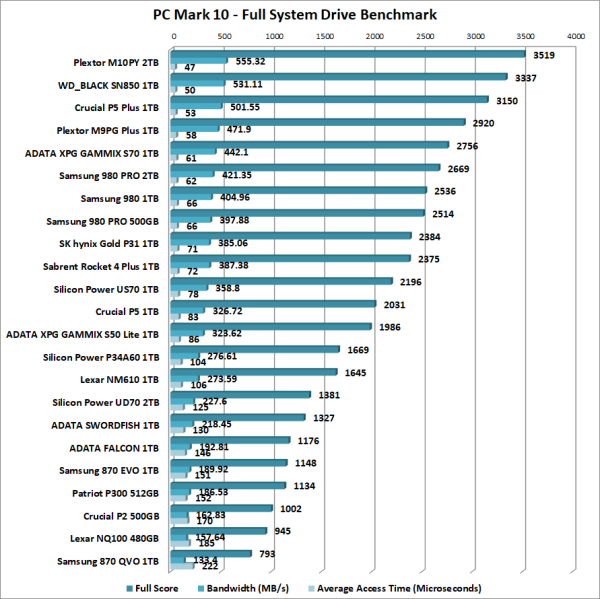
Thanks to its high bandwidth and low latency, the P5 Plus did quite well in PCMark 10's Full System Drive Benchmark. Unfortunately, this wasn't enough to top the WD_BLACK SN850 or the Plextor M10PY.
TRIM Performance:
While SSD's offer many benefits, there are some downsides to using flash memory. One of the biggest issues people run into is performance degradation. Over time, an SSD will run out of fresh blocks and will have to write over data the file system has marked as deleted. This procedure is very complicated and can slow an SSD's write speeds considerably.
To fix this problem, most manufacturers have added TRIM support to their SSDs. The TRIM command allows an operating system, such as Windows 10, to tell an SSD which data blocks are no longer in use. Using this information, the drive pro-actively erases these blocks and adds them to the free block pool.
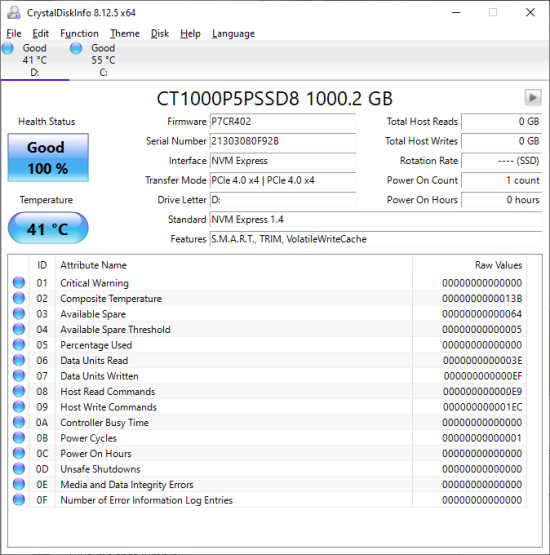
To test the P5 Plus's TRIM and garbage collection functions, I first put the drive in a "dirty" state. I used Iometer to fill 80% of the drive and then ran a random write test for 30 minutes. Looking at the screenshot below, you can see that the P5 Plus' average read and write speeds dropped to 778.19 MB/s and 1060.52 MB/s, respectively.
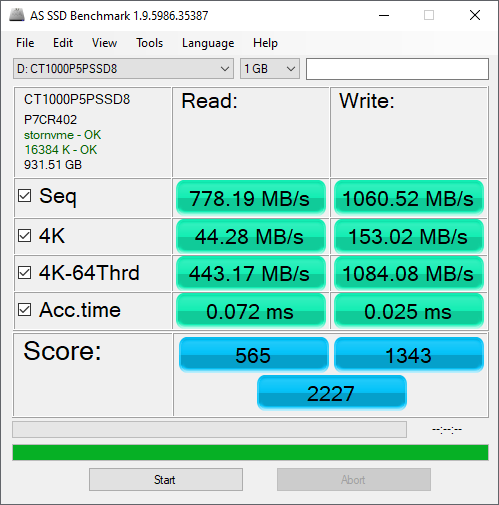
Crucial P5 Plus - Dirty
To see how well the P5 Plus could recover, I let the computer sit for about 30 minutes and then reran the test. The drive's average read speed climbed up to 5249.19 MB/s. However, its write speed lagged behind, averaging out at only 3682.06 MB/s.

Crucial P5 Plus - After TRIM
Lastly, I used Parted Magic to perform a secure erase on the P5 Plus. With the drive wiped clean, it had average read and write speeds of 2782.33 MB/s and 2513.49 MB/s, respectively.
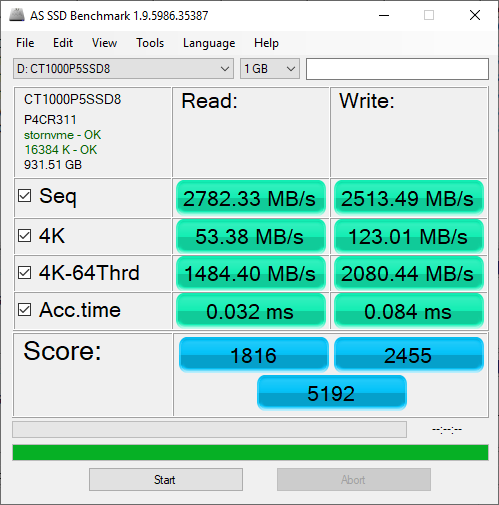
Crucial P5 Plus - Secure Erased
Adaptive Thermal Protection:
While PCIe SSDs like the P5 Plus offer impressive performance, they also generate a good amount of heat. To keep them from overheating, Crucial has implemented what they call Adaptive Thermal Protection. This technology monitors the temperature of a drive and will automatically reduce its performance when it reaches a certain point.
While not the hottest SSD we've looked at, the P5 Plus can get get a bit toasty. At idle, temperatures hovered around 50 ºC. When pushed hard, the drive reached temperatures as high as 76 ºC when reading and 74 ºC when writing.
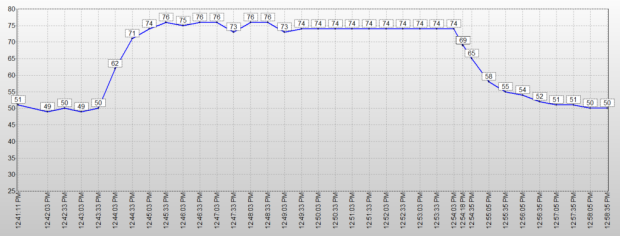
These temperatures had no impact on the P5 Plus' write speeds. However, when it would exceed 76 ºC, Adaptive Thermal Protection would kick in and throttle the drive's sequential read speed. The P5 Plus gradually slowed until its temperature dropped below 76 ºC. Once it reached this point, it would speed back up again.
Final Thoughts:
The Crucial P5 Plus is a great choice for the gamer or creative professional looking for a fast, yet affordable, PCIe 4.0 SSD for their computer or gaming console. Designed and built entirely in-house, this M.2 form factor SSD is powered by Micron's cutting-edge DM01B2 controller and is available with up to 2TB of the company's 176-layer 3D TLC NAND flash. Combine this with a PCIe Gen4 x4 NVMe 1.4 interface and you have drive that is capable of performance nearly double that of Crucial's previous PCIe SSDs. The P5 Plus flew through our sequential transfer rate tests, reading at speeds as high as 6,852 MB/s and writing at more than 5,000 MB/s. The drive's performance wasn't quite as impressive when doing random writes. Nevertheless, it was able to produce more than 145,000 IOPS at low queue depths.
Of course, fast read and write speeds aren't the only things the P5 Plus has to offer. In addition to a large DRAM cache, the drive uses technologies like Dynamic Write Acceleration to optimize performance as well as multistep data integrity algorithms and Redundant Array of Independent NAND (RAIN) to protect data and prevent it from becoming corrupted. The P5 Plus also features thermal and power loss protection, active garbage collection, NVMe Autonomous Power State Transition (APST) support and full hardware-based encryption. To top it all off, it comes with Acronis True Image cloning software and is covered by a generous 5 year warranty.
The Crucial P5 Plus is available now in 500GB, 1TB and 2TB capacities. Prices on Amazon.com currently range from $108 up to $368, with the 1TB version reviewed here retailing for about $180.

Highs:
- Available in 500GB, 1TB and 2TB capacities
- PCIe 4.0 x4 interface with NVMe protocol
- Micron DM02A1 controller
- Equipped with Micron 176-layer 3D TLC NAND
- Excellent sequential read and write performance
- Good random read and write performance
- Small M.2 2280 form factor
- Large DRAM cache
- Dynamic Write Acceleration
- Supports Redundant Array of Independent NAND and Multistep Data Integrity Algorithms
- Full hardware-based encryption
- Supports TRIM and active garbage collection
- Thermal and power loss protection
- Includes Acronis True Image cloning software
- Reasonably priced
- 5 year warranty
Lows:
- Write speed drops when SLC cache is full
- Gets hot under heavy workloads

